
Case Report
Austin J Anesthesia and Analgesia. 2023; 11(2): 1118.
Anesthetic Management of Patient with an Oesotracheal Fistula (Case Report)
Hicham Hammadi¹*; Mouad Amraoui²; Youssef Halhoul¹; Achraf Jeddab¹; Ahmed Fakri¹; Hamza Kassimi¹; Abdelhamid Jaafari¹; Omar Slaoui¹; Abderrahman El Wali¹; Mohammed Meziane¹; Mohamed Rabi Andaloussi¹; Massine Elhamoumi²; Elhassan Kabiri²; Hicham Balkhi¹; Mustapha Bensghir¹
1Department of Anesthesiology and Critical Care, Military Teaching Hospital Mohammed V, Faculty of Medicine and Pharmacy of Rabat, Mohammed V University of Rabat, Rabat, Morocco
2Thoracic Surgery Department, Military Teaching Hospital Mohammed V, Faculty of Medicine and Pharmacy of Rabat, Mohammed V University of Rabat, Rabat, Morocco
*Corresponding author: Hicham Hammadi Department of Anesthesiology and Critical Care, Military Teaching Hospital Mohammed V, Faculty of Medicine and Pharmacy of Rabat, Mohammed V University of Rabat, Rabat, Morocco. Email: hichamhammadi418@gmail.com
Received: November 20, 2023 Accepted: December 23, 2023 Published: December 30, 2023
Abstract
Oesotracheal Fistulas (OTF) are rare, but their etiologies are manifold. Their severity is due to the passage of digestive tract contents into the trachea, bronchi and lungs, and the resulting infections. These infections, combined with undernutrition, contribute to the deterioration of the patient’s general condition, and the prognosis can be life-threatening [3].Currently, around 50% of acquired OTFs are benign [1]; in the literature, over 75% result from trauma to the endotracheal cuff in patients on prolonged mechanical ventilation [1]. The two main objectives of anesthetic management are to manage the airway preoperatively and intraoperatively, and to enable spontaneous ventilation as soon as possible postoperatively [4]. Determining the duration of surgery is a crucial step in the successful management of OTF, and immediate extubation is the goal [4]. Postoperatively, all cases of OTF repair should have a nasogastric tube or percutaneous endoscopic gastrostomy for at least 9 days[4].
Introduction
Acquired benign Oesotracheal Fistula (OTF) is a rare but serious pathology. It is a potentially fatal affection due to pulmonary complications, about 50% of acquired OTFs are benign [1].There are many variable causes that have a significant role in such a complication. Tracheal intubation with cuff-related lesions is the most common cause [2]. The proximity of the esophagus, trachea, upper mediastinal structures and large blood vessels can further complicate anesthesia and surgical procedures[1]. We report an observation of a 20-year-old autistic patient with a post-tracheostomy esotrachealfistula.
Observation
Patient aged 20; programmed for Oserotracheal Fistula (OTF) diagnosed by cervico-thoracic (CT) scan and esophageal fibroscopy with antecedent autism since childhood and cellulitis treated for 3 months for which he was operated with placement of a tracheotomy for 40 days complicated by an OTF; Pre-anaesthetic evaluation: patient weight 70 kg, height 1.70 m (BMI 24); respiratory status: patient reported false routes with chronic cough and whitish sputum; respiratory rate 20 cycles/min, SpO2: 100% on ambient air, respiratory auscultation was normal; chest x-ray was normal, chest CT showed lung parenchyma without abnormality and absence of tracheal stenosis, fistula was 2 cm from vocal cords; blood pressure was normal with heart rate at 90 beats/min, no murmur on cardiac auscultation; neurologically: difficult contact with agitation; no sensitivo-motor deficit, pupils equal and reactive. Airway assessment: presence of difficult ventilation and intubation criteria: limited mouth opening, retrognatism and a thyromental distance <65 cm (fig. 1, 2,3). The rest of the examination was without particularity. Preoperative laboratory results: haemoglobin 12 g/dl; platelet count 450000 /mm3 ; urea 0.17 g/l; creatinine 6 mg/l; kalaemia 3.7 mmol; Na+ 136 mmol; CRP 5; procalcitonin negative; ABO RH grouping :A+.
After consultation with the surgeons: the procedure will be performed via an anterior cervical approach, and the anesthetic protocol consists of sedation with sevoflurane; then airway management via nasotracheal intubation with fibroscopy in spontaneous ventilation; then, as soon as the fistula is located, the patient is reintubated by the surgeons via a montandon tube; at the end of the procedure, the patient is reintubated orotracheally via a simple tube using videolaryngoscopy.
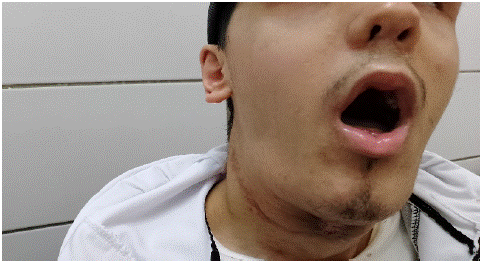
Figure 1:
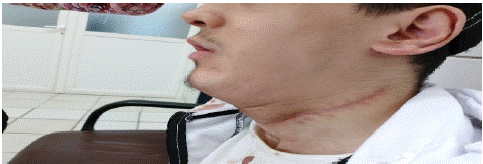
Figure 2:
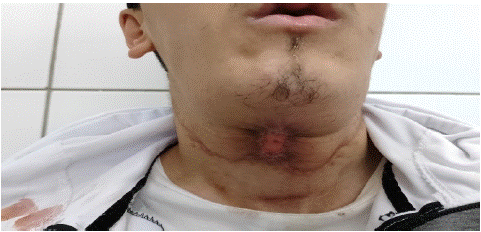
Figure 3:
On the day of surgery: patient admitted to the operating room at 8 am, sedated on spontaneous ventilation with sevoflurane after attachment (very agitated patient), placed in dorsal position, non-invasive monitoring: ECG, O2 saturation, blood pressure, capnography, 2 16-gauge venous lines. Antibiotic prophylaxis: Rocéphine 2g + Flagyl 1g. Airway management was ensured by fibroscopic nasotracheal intubation (Figure 4) with sedation using ketamine 50mg + 2 MAC of continuous seOn the day of surgery: patient admitted to the operating room at 8 am, sedated on spontaneous ventilation with sevoflurane after attachment (very agitated patient), placed in dorsal position, non-invasive monitoring: ECG, O2 saturation, blood pressure, capnography, 2 16-gauge venous lines. Antibiotic prophylaxis: Rocéphine 2g + Flagyl 1g. Airway management was ensured by fibroscopic nasotracheal intubation (Figure 4) with sedation using ketamine 50mg + 2 MAC of continuous sevoflurane, while maintaining spontaneous ventilation. Intubation was difficult (2 attempts) with normal probe number 5, after visual verification by fibroscope of the location of the distal end of the probe (The fistula was proximal, located 2 cm from the vocal cords, and the tip of the tube was distal, facing the carina.), the baloneum was inflated followed by induction with 200 ug of fentanyl, 200 mg of propofol and 50 mg of esmeron. The patient was then connected to the ventilator in controlled assisted ventilation mode: tidal volume 440 ml; FR 14 cycles/min; PEEP 5 cmH2O; I/E 1:2.
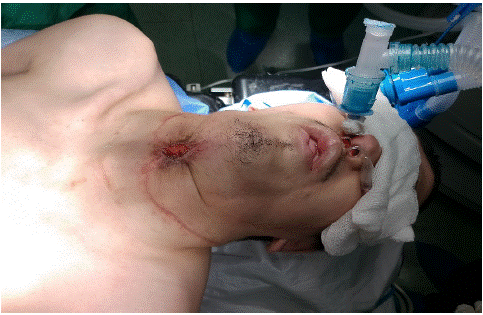
Figure 4:
The patient was catheterized with a number 14 urinary catheter, then placed in dorsal decubitus with a log placed under the shoulder blades, head in extension. After relocation of the fistula by esophageal fibroscopy, FIO2 was increased to 100% for 3 min to avoid desaturation episodes when the intubation tube was changed. The nasotracheal intubation tube was then gently removed, and ventilation was ensured by a Montandon tube (Figure 5) inserted by the surgeons after opening the trachea; before tracheal anastomosis, the patient is reintubated orally with a videolaryngoscope and Eichmann guide with a single number 5 tube; verification is ensured by vision by the surgeons and by capnography. A nasogastric tube was inserted at the end of the procedure and left in place. The surgical procedure consisted of an anterior closure of the orotracheal fistula at cervical level with resection-anastomosis of the trachea, and lasted 3h without intraoperative incident. Blood loss was 300cc.
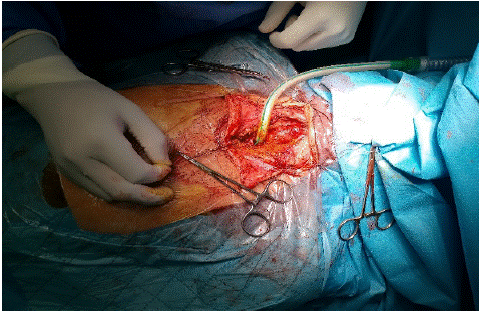
Figure 5:
The patient woke up with light sedation during the first night. The patient was extubated (figure:6) at h12 after sedation had been stopped and prerequisites had been acquired. Immediate operative follow-up was uncomplicated. The patient was taken to the service at h 48.
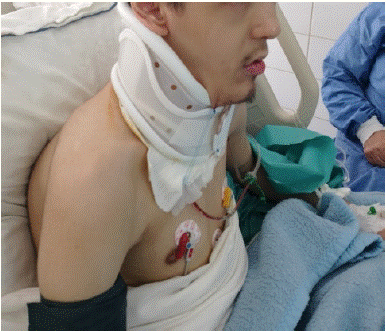
Figure 6:
Discussion
Oesophagotracheal Fistulas (OTF) are rare, but they have multiple causes. Their severity is due to the passage of digestive contents into the trachea, bronchi, and lungs, leading to infections. These infections, combined with malnutrition, contribute to the overall deterioration of the patient's health, and their prognosis can be life-threatening [3].
Among the non-malignant causes of acquired EOTF reported in the literature, over 75% are the result of trauma related to the endotracheal balloon in patients undergoing prolonged mechanical ventilation [1]. Secondary erosion of the tracheal and esophageal walls occurs with an incidence of 0.3 to 3% in mechanically ventilated patients [5]. Reported mechanisms of injury include traumatic intubation, airway suctioning, and compression of the vessels in the tracheal wall leading to ischemia and local ulceration. Ischemia of the tracheal wall is a well-known complication resulting from prolonged overinflation of the endotracheal balloon [1].
The risk of developing acquired OTF is further exacerbated by the presence of any of these factors: poor general health, malnutrition, respiratory tract infection, episodic hypotension, diabetes, steroid use, posterior pressure from nasogastric tubes, and prolonged mechanical ventilation [1].
Acquired OTF should be suspected in ventilated patients when there is a persistent air leak despite overinflated balloon; abdominal distension; contamination of the tracheobronchial tree with food particles and digestive secretions; recurrent lung infection; unexplained weight loss; and repeated weaning failures [4].
In spontaneously breathing patients, the clinical symptoms and signs include the ONO sign [6] (persistent cough following swallowing without any other swallowing disorder), coughing with expectoration of food particles, and often discolored bile. Additional features in the patient's history that may raise suspicion of OTF are a history of trauma, ingestion of caustic substances, hemoptysis, chest pain, dysphagia, dyspnea, recurrent respiratory tract infections, and fever of unknown origin [1]. Our patient presents with false routes and a persistent cough..
The radiological assessment provides valuable information for the etiological diagnosis [5]. Computed tomography with contrast injection has become the gold standard examination [3]. The diagnosis is confirmed through endoscopy: bronchoscopy and esophagoscopy [4]. In our case, due to the patient's autism and difficult contact, direct opacification was not possible. Instead, the diagnosis was confirmed through esophagoscopy performed under sedation.
Most authors recommend intervening on a patient who has been successfully weaned from the ventilator and has a satisfactory nutritional status [3]. At the time of anesthesia consultation, the patient was in good general condition with a Body Mass Index (BMI) of 24, and there were no clinical or radiographic signs of a lung infection.
The two main objectives of anesthesia management are the preoperative and intraoperative management of the airways and the possibility of early postoperative spontaneous ventilation. Anesthesia for the patient must be carried out with excellent coordination and communication [4].
Rapid isolation of the OTF is crucial for a successful anesthetic management. Positive pressure ventilation should be avoided before securing the fistula, as it may lead to gastric dilation and aspiration. For confirmed proximal fistulas, a rapid sequence induction with Sellick maneuver can be performed after adequate preoxygenation. Succinylcholine or rocuronium can facilitate rapid intubation, avoiding the need for positive pressure ventilation [1]. Alternatively, a vigilant nasotracheal intubation with a flexible fibroscope can be a good option, allowing the distal end of the intubation tube to be placed away from the fistula under visual control. A nasogastric tube, placed before induction and left on free drainage, helps avoid gastric dilation [1]. Once the OTF is isolated, ventilation can proceed without issues. Anesthesia can be maintained with a volatile or total intravenous anesthetic agent. The patient should be adequately paralyzed to facilitate the surgical procedure, which may last up to 4 hours. After the OTF repair, the endotracheal tube should be removed proximally, and a leak test should be performed. The tube must be reinserted, and ventilatory modes adopted to avoid unnecessary stress on the surgical repair. Controlled ventilation and high-frequency ventilation have been reported in the literature, but no specific ventilatory mode is favored preferentially [1].
In addition to managing the OTF, our patient presented two other challenges: difficult airway management due to ventilation criteria and autism. To address these challenges, a decision was made for nasotracheal intubation under fibroscopy with light sedation while maintaining spontaneous ventilation.
The main objectives of curative surgery are primary closure of the fistula and prevention of recurrences. The optimal surgical approach depends on the site, length, distance from the vocal cords, and distance from the carina of the fistula. Regardless of the chosen approach, single-stage repair is preferable in most fistulas [4]. The surgical timeline and details were discussed with the surgeons, and communication methods between the anesthesia team and surgeons during the procedure were agreed upon concerning ventilation control and airway management.
Extubation should be the goal and should be performed with cautious use of opioids and curare during the procedure [1]. Given the patient's autism, extubation was planned in the intensive care unit in a calm environment, and the patient was extubated at 12 hours after the procedure with the full team present.
For most proximal fistulas involving cervical incisions, local infiltration and multimodal analgesia are generally sufficient [1]. In our case, multimodal analgesia with paracetamol and nefopam was used and proved effective in pain control.
In the postoperative period, all cases of OTF repair should have a nasogastric tube or percutaneous endoscopic gastrostomy for at least 9 days. This is done to protect the esophageal repair site from gastroesophageal reflux, which may affect the repair site and increase the risk of recurrence and esophageal stricture [7]. The fistula is reevaluated through radiographic studies with contrast, bronchoscopy, and esophagoscopy. After confirming no leakage, the feeding tube can be removed, and oral intake can begin [4].
Thoracic physiotherapy sessions and liquefaction of respiratory secretions using nebulized saline are very useful and practical. Periodic bronchoscopy may be necessary to remove respiratory secretions [4]. It is also important to reassure the patients and encourage early mobilization [4].
Conclusion
Acquired benign oesophagotracheal fistula is a rare and serious condition. The diagnosis relies primarily on clinical, radiological, and endoscopic methods. Anesthetic management aims to adequately prepare the patient for the surgical procedure and manage the airways in the preoperative and intraoperative stages, with the primary goal of achieving early extubation in the postoperative period. The collaboration and coordination between the anesthesia team and surgeons are crucial for the successful outcome of the pathology. Overall, a multidisciplinary approach, careful planning, and individualized care are essential in managing this complex and challenging condition.
References
- Diddee R, Shaw IH. Acquired tracheo-oesophageal fistula in adults. Contin Educ Anaesth Crit Care Pain. 2006; 6: 105-8.
- Davari HR, Latifi S. Successful airway management in a patient with tracheal stenosis and tracheoesophageal fistula: a case report. Acta Med Iran. 2014; 52: 565-8.
- Masson E. Traitement des fistules oesotrachéales. EM-Consulte n.d. 2013; 46-440.
- Santosham R. Management of acquired benign tracheoesophageal fistulae. Thorac Surg Clin. 2018; 28: 385-92.
- Couraud L, Ballester MJ, Delaisement C. Acquired tracheoesophageal fistula and its management. Semin Thorac Cardiovasc Surg. 1996; 8: 392-9.
- He J, Chen M, Shao W, Li S, Yin W, Gu Y, et al. Surgical Management of 3 Cases with Huge tracheoesophageal fistula with Esophagus Segment in situ as Replacement of the Posterior Membranous Wall of the trachea. J Thorac Dis. 2009; 1: 39-45.
- Coran AG. Diagnosis and surgical management of recurrent tracheoesophageal fistulas. Dis Esophagus. 2013; 26: 380-1.